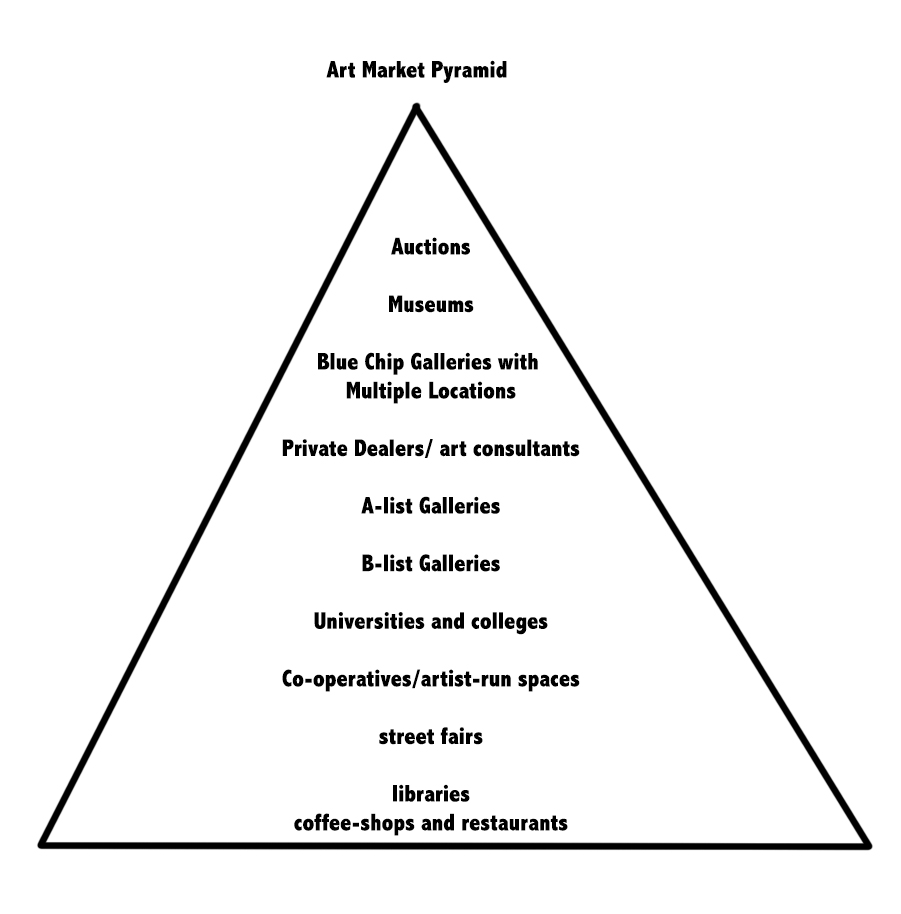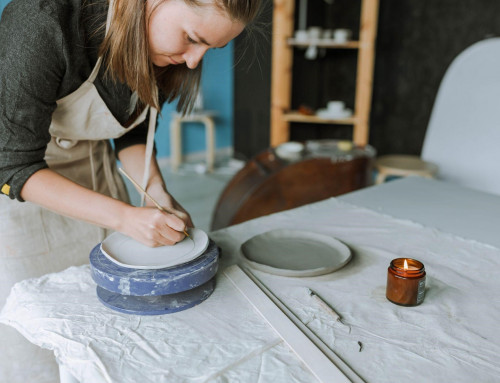Learn as Much as You Can About the Art Business
It’s an Odd, often Opaque Business
Did I catch your attention with the cute puppy?
(Gracie asks,”Is that a treat in your hand?”)
Are you confused about where you fit in the art world? So am I!
(Gracie, the studio dog, is confused about everything! But she still has aspirations!)
Learn as Much as You Can. I think we all struggle with this! There are so many kinds of art and so many places to look…where to start?
First, you need some way to define your art and your audience. Who do you think is your audience? age, gender, education, income, location. Don’t worry about how precise you are here, but do take a stab at it. If you have business social media presence, look at the insights/analytics.
What is your media? Is it figurative or abstract? Is the content challenging or easy? Where is your art on the spectrum from highly charged political/sexual/violent content to easily recognizable illustrations , e.g landscapes, florals, portraits. Is it highly expert or emerging? Is it small or large? What is your price range?
If you don’t know the answers, just do your best to guess. This exercise will help you figure out where your work might belong.

Gideon, the late great studio dog. He did not have many aspirations as each day was “THE BEST DAY EVER!” in Gideon world…especially if he had his stuffed puppy.
Are you still with me? Or did you already fall asleep?
I know. It’s hard to think about. It took me years to understand that “your audience” is simply people who like your art, are interested in what you do or, “hooray!” have actually bought your art. Having some ideas or guesses about your audience will help in this next section because you need to have an vision of whether you might find your audience among these locations!
Location, Location,Location
I’m not talking about specific cities right now, although that is important and may be the subject of a future post. I’m actually talking about the economic structure of the art world. I have studied this for years and while I am still no expert, here is what I have learned.
 I drew the sectors of the market, as I understand it, in a pyramid for a reason. I don’t think of this as a VALUE enumerator. It’s not about status or even money. It’s about HOW MANY ARTISTS PARTICIPATE at any level. As we work our way down the pyramid from its apex, you will see how the number of artists involved at each level increases…they sort of form a giant lake of opportunity toward the bottom!
I drew the sectors of the market, as I understand it, in a pyramid for a reason. I don’t think of this as a VALUE enumerator. It’s not about status or even money. It’s about HOW MANY ARTISTS PARTICIPATE at any level. As we work our way down the pyramid from its apex, you will see how the number of artists involved at each level increases…they sort of form a giant lake of opportunity toward the bottom!
[su_box title=”AUCTIONS” box_color=” #666666″]AUCTIONS– with only a very few exceptions, artists do not participate directly here nor do they get money directly from these sales. This is the secondary market where individuals sell their artwork with the hope of making a profit on their investment. The benefit of a successful auction result to an artist, is the effect on their pricing. Auction sales can raise the prices of artists work…but they can tank the prices as well. If you have a history of enough sales for a collector to participate in this market…Good for you! (By the way, if the auction house is in Europe, the artist does get a percentage of the sale. But, in the US, the artist does not receive a percentage.)[/su_box]
[su_box title=”MUSEUMS” box_color=” #666666″]MUSEUMS- Museums build their collections through acquisition budgets, estate plans, gifts, as well as promised artworks from trustees. To become a trustee of a major museum, you are expected to donate time, money and art to the institution and bring in more donors from your circle of friends and colleagues. Acquisition budgets are small compared to the auction prices. Acquisitions can be hotly contested. The curators do deep research and make their best case to the staff and trustees for how to spend the available money and raise more. They can run up against the politics and desires of the wealthy donors and trustees. Museum acquisitions raise the market value of artworks and the collections they come from. The debate about acquisitions and transactions are supposed to be arms-length, but museums are, after all, human institutions.[/su_box]
[su_box title=”BLUE CHIP GALLERIES” box_color=” #666666″]BLUE CHIP GALLERIES- These are the top sellers in the retail artworld. The top of the heap have multiple locations.(Gagosian, Hauser &Wirth, Zwirner) But do not fool yourself. These galleries are not STORES. You and I cannot walk in to one of their locations and purchase something off the wall. Our worthiness is vetted. It’s not enough to have the cash. You also have to have caché! Your purchase must benefit the artists reputation, hence benefiting their pricing structure. For the general public, even the nouveau- riche, these galleries function more like museums. So, HOW DO THEY STAY OPEN?
The underlying structure of most of these galleries has four major components:
1) ESTATES. This is a large part of the financial stability. Estates of popular artists and private collectors are hotly pursued and, truthfully, traded around the upper echelons of the artworld. This might be estates of contemporary, modern or old masters, depending on the gallery. Occasionally they own some of the artwork, making a sale more profitable. But mostly they have complicated contracts with artist’s and collector’s estates. The income stream is more predictable from this segment. Strategies are applied to increase value, such as museum placement, holding onto inventory until auction prices rise, sometimes helping to bring up auction prices through bidding with no intent to buy.
2) CONTEMPORARY artists on the roster. These are the sales leaders of living artists who have a representation agreement with the gallery. This may or may not be an actual contract. Artwork is usually shown on consignment. If the gallery is large enough, the artists may receive a stipend to produce new work. Some expenses of production paid for by the gallery may be deducted from the sales, depending on the agreement. The agreement, in implication at least, is that the gallery will support and promote a represented artist’s career, managing their sales and exposure to benefit reputation and sales prices. This is managed through careful placement (the high-end word for sales!) of work in important collections and museums; through scholarly catalogs and publications. The agreement can also limited where the artist may show. Sometimes agreements are exclusive. Sometimes multiple galleries create agreements to promote the same artist in different geographical locations.
3) NEW OR EMERGING ARTISTS. The reality on the ground is that all galleries still need to find new artists and new collectors. How do they do this? They take a risk on showing new talent at somewhat lower prices. Most of them state they do not look at portfolios. They travel to top flight graduate art schools like Yale and look around. They listen to the recommendations of their represented artists and important collectors. And, yes, they do look at who the other galleries are showing and sometimes “poach”. Emerging artists might be invited to develop and exhibit in a designated experimental space that the gallery manages. They might be tried out in a group show or two. They are unlikely to be represented right away.
4) A fourth component that is in flux due to fuel/climate costs, is International Art Fairs, like Art Basel, Frieze, SOFA etc. These are select events for galleries to present their “best” to a broader audience. They are available all over the world now. It takes deep pockets and lots of staff to do them, but for many galleries they still make a significant financial difference![/su_box]
[su_box title=”PRIVATE DEALERS/ ART CONSULTANTS” box_color=” #666666″]PRIVATE DEALERS/ ART CONSULTANTS- I’m not sure where on the pyramid this group belongs. There is lots of opportunity here. PRIVATE DEALERS are people who have a robust list of established collectors/buyers. The private dealer quietly caters to their needs. They have no public gallery space, although there may be occasional private viewing events. The only private dealer I have known was a print specialist: he started as an educated collector of fine prints and began offering them to select collectors…perhaps as a way to fund his own habit? It was a quiet, almost invisible business, but it worked well.
ART CONSULTANTS come in a variety of forms. Some are agencies who are contacted by decorators and businesses to provide art as ambience. Some work with architects. Some are private consultants to private people, shopping for them. Some are truly full service and include framing, shipping and art installation in their list of services. Depending on their focus, they keep rather large databases of art and artists to share with their clients. I have received commissions based on my work in their databases.[/su_box]
[su_box title=”A-LIST GALLERIES” box_color=” #666666″]A-LIST GALLERIES- I define these as single location galleries or, at most, 2 locations. They can certainly be powerhouses in their own right, like PAULA COOPER GALLERY. They pretty much operate like the humongous Blue Chip galleries, just on a smaller scale. They are careful, supportive of their artists, produce scholarly publications, participate in some of the art fairs, represent some estates and generally manage their represented artists careers. A-List galleries may have specialties, e.g. a love of materiality or prints. They may occupy a niche market, betting on their deep knowledge of a particular part of art production. They vet their buyers just like the large galleries.[/su_box]
[su_box title=”B-LIST Galleries” box_color=” #666666″]B-LIST Galleries- I define these as successful retail operations with a reasonable collector base. They don’t represent estates as much. Nor do they necessarily represent artists in the same way as the blue chip galleries. They are unlikely to provide a stipend or finance production costs of new work. Hence they need to rely on their educated eye, connections and good sales techniques to stay afloat. And many of them do thrive. They tend to me more democratic in their sales. If you have the cash, you might be allowed to buy the art.[/su_box]
[su_box title=”UNIVERSITY AND COLLEGE ART GALLERIES AND MUSEUMS” box_color=” #666666″]UNIVERSITY AND COLLEGE ART GALLERIES AND MUSEUMS There are a lot of opportunities to have exhibits in educational institutions. Some are more prestigious than others (like YALE!). Generally they cost little or nothing to apply. Occasionally they pay an honorarium to offset you expenses. Less frequently, they provide a budget to get you there, get your work there and have you teach. Are there sales? Generally no. But you can sometimes get work into their collections- either purchased or donated. These opportunities have potential networking value. And, certainly, you do get a resume point to help you get the next show. Be sure to consider the hidden costs like shipping and travel.[/su_box]
[su_box title=”COOPERATIVES AND ARTIST RUN SPACES” box_color=” #666666″]COOPERATIVES AND ARTIST RUN SPACES- Cooperatives are member based organizations. The costs to be a member vary widely as do the responsibilities of membership. Some cooperatives are long lived and respected. Some, not so much. Some cooperatives have rigorous jurying to become a member. Some do not. Some have professional staff. Some do not. What they all offer is some guarantee of having exhibitions. Some exhibitions are reviewed. Most are not. Minimal publications. Sometimes they have open calls for art which may get your art seen in a market you want to explore. Do they make sales? maybe. I think you can expect the price points to be lower that any of the Blue Chip or A-list galleries.
HOW ARE ARTISTS RUN SPACES DIFFERENT? not much. Some are well established. They can, however, be shorter lived, more mobile in location and more experimental. They are a great place to try out new, challenging work and meet other artists. Financially they run in lots of different ways: pooling personal resources, grants and collecting fees from exhibitors. You too can open an artist’s run space in your garage![/su_box]
[su_box title=”FESTIVALS and STREET FAIRS” box_color=” #666666″]FESTIVALS and STREET FAIRS- These are the local and national arts and craft fairs. Some, like the American Craft Council Fairs are highly professional and competitive to enter. The expenses are relatively high, between application and booth fees, booth building, travel expenses. The payoffs can be high as well. And they are prestigious. But there are loads of other art fairs, both juried and first come first served. There are still expenses to consider, including jury fees, booth fees, booth building, speculative stock production, time away from the studio, travel expenses. If your work fits here, it is possible to make a living. If you are measuring profits after cost of production and sales, the percentages can be pretty low…but the cash flow can be pretty seductive and enough to keep you in them. Weather is, of course, a real risk factor, even for the indoor fancy fairs. The art fairs are generally very time limited : 1-5 days in duration. If the snow or tornadoes hit, you are out of luck and may even loose stock to storm damage. Consider carrying insurance.[/su_box]
[su_box title=”LIBRARIES, COFFEESHOPS, RESTAURANTS ” box_color=” #666666″]LIBRARIES, COFFEESHOPS, RESTAURANTS have walls to fill and sometimes have “exhibition programs” where they jury what is shown. They are not particularly prestigious nor are sales robust. But your work does get seen. It’s certainly a start for an exhibition career. And one of my favorite pieces in my collection, I bought in a coffeeshop 30 years ago. And BY THE WAY, lots of churches have art programs, some with awards and some have robust collections. So do some libraries! Prestigious? Only locally.[/su_box]
[su_box title=”DID I MENTION ONLINE GALLERIES?” box_color=” #666666″]DID I MENTION ONLINE GALLERIES? Online galleries help build visibility and name recognition, raising your SEO scores(search engine optimization). Sales appear tepid unless the online gallery is associated with a Blue Chip or A-List gallery.[/su_box]
I needed a “cute” break. How about you?
[su_divider style=”dotted”]
SO WHERE DO I SHOW? AND WHAT ARE MY ASPIRATIONS?
I currently show in artist run spaces, educational institutions and what I call B-list galleries with a smattering of local churches and online events and the occasional art consultant.
In the past I showed very successfully in street fairs and libraries. Street fairs favor lowish prices and function…like ceramics, which I made for many years. My artist books phase took my work to collecting libraries including the Museum of Modern Art. And now, my textile based sculptures belong in galleries and some of the work is appropriate for art consultants.
I aspire to an A-List gallery and more museums. (So does Gracie the Studio Dog. She is learning how to pose in the middle of works in process!)
WHERE AM I SHOWING NEXT?
NOW-Seeing God, Benedictine Monastery of St. Paul, MN
NOW- 6th Annual National Juried Show, Wausau Museum of Contemporary Art, Wausau, WI
NOW- Landscapes Art exhibition, Artist Space Online Gallery, online
NOW-57th National Drawing and Small Sculpture Show, DeMar College, Corpus Christi, TX
NOW-Revolutionary, Fresh Eye Gallery, Minneapolis, MN
NOW-Selections from A Common Thread. Carnegie Art Center, Mankato, MN
MAY- Bending Toward Beauty(solo), Springfield Art Assn, Springfield, IL
JULY-Women Take The Walls, Garrett Museum of Art, IN
APRIL Fiber Reimagined, Fiber Art Now Magazine
ALL OF 2023- Objects of Agency, Hera Gallery, Wakefield, RI- online








